December 2022 - You are accessing an archived version of our website. This website is no longer maintained or updated. The Sustainable Development Knowledge Platform has been migrated here: https://sdgs.un.org/
December 2022 - You are accessing an archived version of our website. This website is no longer maintained or updated. The Sustainable Development Knowledge Platform has been migrated here: https://sdgs.un.org/
The theme of the 2017 High-level Political Forum on sustainable development will be “Eradicating poverty and promoting prosperity in a changing world”, which is also a central promise of the 2030 Agenda for Sustainable Development. In the lead-up to the 2017 HLPF, weekly blogs by representatives of Member States, UN system, and major groups and other stakeholders will be featured in this series to present various perspectives on this theme. The role of SDGs 1, 2, 3, 5, 9, 14, and 17 will also be highlighted, as these goals will be in focus at the 2017 HLPF discussions.
Click here to see all the HLPF 2017 blog entries

Kathy Calvin, Chief Executive Officer of the United Nations Foundation
In the Za’atari refugee camp in Jordan, a group of adolescent girls known as the TIGER girls (which stands for “These Inspiring Girls Enjoy Reading”) are focused on learning languages and other skills so they can pursue their dreams to become doctors, teachers, and engineers.
As young girls forced to flee their homes and now living in poverty, they are among the most vulnerable people on the planet – and their needs must be at the forefront of the international community’s work to achieve the Sustainable Development Goals (SDGs).
Only when we reach the furthest behind will we realize the promise to end poverty and “leave no one behind.”
Under the Millennium Development Goals (MDGs), the world made important progress in helping empower millions of people to move out of poverty. But as we approached the end of the MDGs in 2015, it was clear this progress was uneven, both between and within countries.
In today’s era of multi-billionaires, approximately 1 in 10 people still live on less than $1.90 a day. While more children live to celebrate their 5th birthdays, millions still die from preventable diseases. And while women continue to break barriers from the boardroom to the classroom, gender inequality persists. If you are girl, especially in a poor, rural community, it’s harder for you to go to school, have a secure job, and chart your own course in life.
Rev. Martin Luther King, Jr. said, “Injustice anywhere is a threat to justice everywhere.” Closing inequality gaps is a moral obligation. It’s also a vital step to grow national economies, stabilize communities, and strengthen global security. Lasting peace will only be possible if we eradicate poverty and injustice.
The Sustainable Development Goals wisely recognize the need to make sure no one is shut out of global progress, universally pledging that “no one will be left behind.”
During the upcoming High-Level Political Forum on Sustainable Development, as governments and stakeholders assess progress on the SDGs, we must pay attention to whether we are reaching marginalized populations, such as adolescent girls, people living with disabilities, LGBTI individuals, minority populations, displaced families, and people living in poor and remote areas, among others.
It’s simple: To achieve the SDGs, we can’t put the most vulnerable last on the global agenda; they must be first.
Research from the Overseas Development Institute (ODI) has found that the longer it takes for governments to act on the SDGs, the harder – and more expensive – it will be to achieve them. Alternatively, strong action yields strong benefits: When we invest in the education, health, and well-being of the furthest behind, we empower people to move from poverty to prosperity, enable economic growth, and reduce long-term expenses.
So how can we put the furthest behind first?
There are a number of steps the global community can take: Governments can put in place targeted policies and budgets that promote equality and opportunity; international donors can increase resources to the countries and people most in need, including by leveraging innovative financing models such as impact investing and green bonds; the private sector can deepen its engagement through new public-private partnerships; and civil society can continue to hold governments and other actors accountable for achieving the “leave no one behind” agenda.
While these steps are essential, they won’t get us far unless they are built on robust, accurate data.
Right now, the most vulnerable people are often under-represented in – or completely missing from – data, which means we don’t have a good picture of who they are, where they are, and what they need. For example, according to the “Leave No One Behind” partnership, among the world’s poorest 20 percent of people, only one-third are registered at birth, which means most of the poorest people in the world are invisible to their governments.
To achieve inclusive development, we need inclusive data. As a global community, we can use the SDGs as a driving force to improve the collection of data so marginalized populations are seen, heard, and counted.
We must also increase our collective ability to disaggregate data, analyze it, and use it to shape policies and programs. The Global Partnership for Sustainable Development Data and Data2X, both hosted at the United Nations Foundation, are working to convene partners to help make sure the data revolution leaves no one behind.
As we implement the SDGs, helping the most marginalized people on the planet may be our most difficult job, but it also our most important. The High-Level Political Forum is a crucial moment to assess our progress and to renew our commitment to this cause.